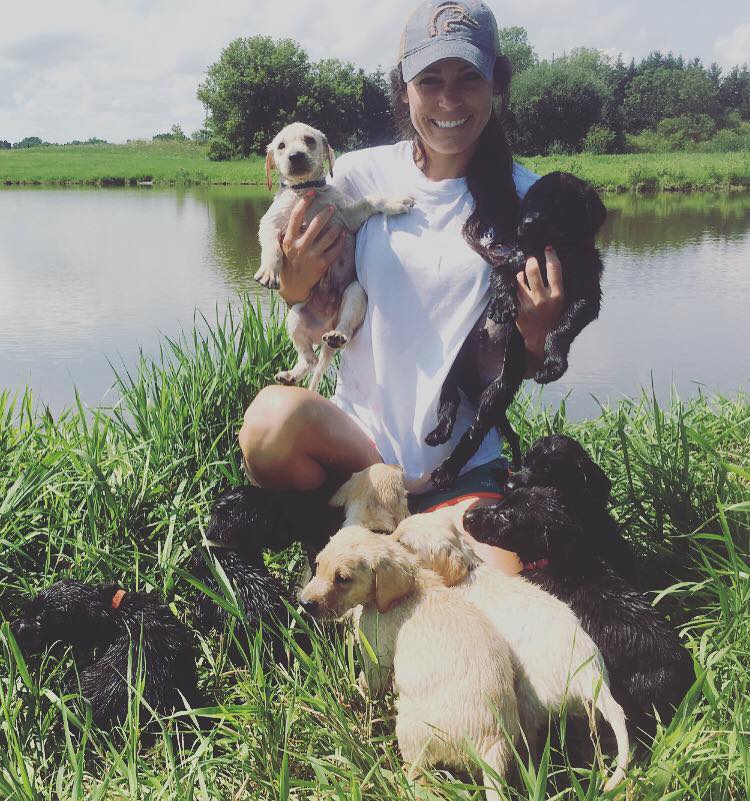Close your eyes and grab one!
That’s one method of picking a puppy. But not necessarily the one that I’d recommend.
The first thing I like to do when searching for my new hunting partner is research the pedigree. Finding the right pedigree doesn’t guarantee you are going to have a great dog. However, in my opinion, it’s the right place to start, and it certainly increases your odds.

Puppies are too adorable to resist. That’s why it’s important to do your homework on a potential litter before they stare you down in person.
I look for field trial or hunt test lines. I like to find litters with multiple titled dogs within a few generations. Preferably FC-AFC or MH.
I know what some of you are thinking: Field trial dogs are all crazy! I’ve heard that a lot in my time training, but in my experience it couldn’t be further from the truth. Sure, some of them are a little over the top, but that can be said for any type of working retriever breed. All of my personal dogs are from field trial breeding, and all are wonderful housedogs, hunting dogs and members of the family. The majority of dogs with strong pedigrees that come to me for training – whether obedience or field training – seem to learn faster and train easier and overall have a better work ethic.
The majority of dogs with strong pedigrees that come to me for training seem to learn faster and train easier and overall have a better work ethic.
Now that you’ve found a pedigree that interests you, what comes next? Some important questions to ask the breeder and to consider: What are the temperaments of the sire and dam? How big are they? Are they high-strung or hyper? Can they -settle down when not working? How are they in the house? What are they like with other dogs and people? What are their health clearances, i.e., hips, eyes, elbows, EiC (exercise induced collapse) or CNM (centronuclear myopathy), for example? What health guarantee do the puppies come with? Most breeders will have a 30-month or so guarantee on hips, eyes, elbows and genetic defects.
Unfortunately, I learned the hard way with my first Labrador retriever. I brought a puppy some years ago from a supposedly reputable breeder. I wanted a good companion, house pet, running partner and hunting dog. When the pup was around 6 or 7 months old, we started formal training for hunting. I was working him on some live birds in 60-degree weather when his back legs started getting wobbly. Soon after he lay down and was unable to stand on his back legs. I was puzzled because at first I thought he overheated, but it didn’t seem warm enough nor had he worked very long or hard that day. I quickly got him into a nearby creek and cooled him off. It took him a while to regain his strength before his back legs were mobile again. I spoke to a few trainers to see if they had witnessed anything similar and went home and did some research. It led me to believe my pup had undergone an episode of EiC. Later that week I went to the vet to get the test done on my dog to verify he was affected by EiC. Long story short, don’t believe the breeder who says, “We don’t need to test for that because our dogs have never shown signs of it.”
Once you’ve found the right pedigree and have the health clearances you’re looking for, it’s time to go and see the litter. A lot of the next part is your personal preference: male or female, what color, bigger or smaller, aggressive or more laid-back, shy or outgoing. Also, make sure the puppies look healthy and that their eyes are bright and not runny, their ears are clean, their skin looks clear, and they are a healthy weight. If it so happens that you can’t go and pick one out yourself, you can explain what things you are looking for, and the breeder should be able to match one up with your desires.
What comes after you get your puppy home? We’ll talk about that next time.
FTK Pro-Tips
Read exclusive training tips and articles writted by Jessie Richards at Full Throttle Kennel.
Jessie Richards owns and operates Full Throttle Kennel, in Campbellsport, Wisconsin. She specializes in training all breeds of retrievers for hunting and AKC hunt tests, as well as guides upland hunters and takes time in October for waterfowl hunting in Saskatchewan.

